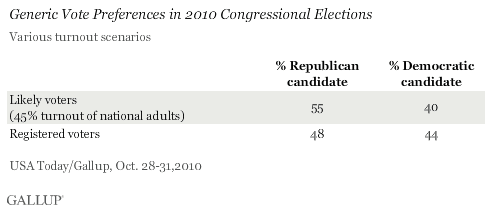Latest Gallup polling is scaring the bejeebers out of the liberals. Heh.
PRINCETON, NJ -- The final USA Today/Gallup measure of Americans' voting intentions for Congress shows Republicans continuing to hold a substantial lead over Democrats among likely voters, a lead large enough to suggest that regardless of turnout, the Republicans will win more than the 40 seats needed to give them the majority in the U.S. House.
The results are from Gallup's Oct. 28-31 survey of 1,539 likely voters. It finds 52% to 55% of likely voters preferring the Republican candidate and 40% to 42% for the Democratic candidate on the national generic ballot -- depending on turnout assumptions. Gallup's analysis of several indicators of voter turnout from the weekend poll suggests turnout will be slightly higher than in recent years, at 45%. This would give the Republicans a 55% to 40% lead on the generic ballot, with 5% undecided.

Republicans' 15-point lead among likely voters contrasts with their 4-point lead, 48% to 44%, among registered voters, highlighting the importance of higher GOP turnout to the election outcome. This wide difference between the GOP's margin among registered voters and its margin among likely voters is similar to the 2002 midterms, in which Democrats led by 5 points among all registered voters in Gallup's final pre-election poll, while Republicans led by 6 points among likely voters -- an 11-point gain.
These final estimates of the vote among registered and likely voters are consistent with Gallup polling since Sept. 23. Republicans have led by an average of 4 points among registered voters and by 16 points among a low-turnout estimate of likely voters since that time. Thus, while voter preferences could change in the final two days, perhaps resulting from Democrats' final push to motivate their base to turn out, voter preferences appear to be quite settled in this final post-Labor Day phase of the campaign.
A Republican Majority Very Likely
Gallup models the number of seats a party will control based on that party's share of the national two-party vote for the House of Representatives, using historical voting data in midterm elections from 1946 to 2006. The model takes into account the majority party in Congress entering the elections.
Gallup's historical model suggests that a party needs at least a two-point advantage in the national House vote to win a majority of the 435 seats. The Republicans' current likely voter margin suggests that this scenario is highly probable, making the question of interest this election not whether the GOP will win the majority, but by how much. Taking Gallup's final survey's margin of error into account, the historical model predicts that the Republicans could gain anywhere from 60 seats on up, with gains well beyond that possible.
It should be noted, however, that this year's 15-point gap in favor of the Republican candidates among likely voters is unprecedented in Gallup polling and could result in the largest Republican margin in House voting in several generations. This means that seat projections have moved into uncharted territory, in which past relationships between the national two-party vote and the number of seats won may not be maintained.
Additionally, efforts by state legislatures in recent years have attempted to insulate incumbent members of Congress from strong partisan tides such as are in force this year. Congressional district lines have been drawn to make them safe for specific parties, which may reduce the impact of national trends on election outcomes.
In the early part of the 20th century, it was not unusual for an election to bring about a change in party control of 50 House seats or more. In recent decades, the partisan shifts have been more modest, with the Republicans' 54-seat gain in 1994 a rare exception.
Turnout Holds the Key
To the extent Tuesday does bring about a strong Republican wave, it will be to a significant degree the result of turnout. Republicans have a slender 4-point advantage in the preferences of registered voters, which expands to 15 among likely voters. Republicans usually turn out at higher rates than Democrats, so the margin's expansion is not unusual, but its size this year is. In general, Republicans' advantage in the vote is strongest in an average turnout scenario, while higher turnout scenarios bring more Democrats into the likely voter pool and increase the Democratic share of the vote.
Republicans' turnout advantage is highlighted by two key questions used as part of Gallup's likely voter model. One asks Americans how much thought they have given to the upcoming elections; the other asks those who say they plan to vote how certain they are about voting.
The Oct. 28-31 poll finds that nationally, 75% of Republicans and independents who lean Republican are "absolutely certain" they will vote in the 2010 midterms, compared with 68% of Democrats. While these figures are not the only indicator of relative turnout strength -- this is just one question in Gallup's seven-item likely voter model -- the record-high seven-point gap between the parties is strongly indicative of a relative surge in GOP turnout.